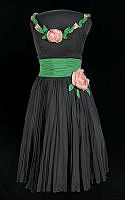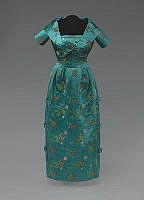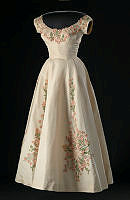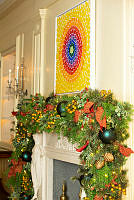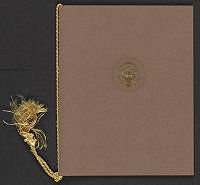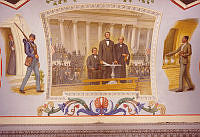Rubenstein Center Scholarship
The Enslaved Household of President George Washington
This article is part of the Slavery in the President’s Neighborhood initiative. Explore the Timeline
On April 16, 1789, George Washington left his home at Mount Vernon to travel to New York City to be inaugurated as the first President of the United States. He was accompanied by Charles Thomson, the secretary of Congress, and Colonel David Humphreys, Washington’s longtime friend and secretary. Although the president-elect made no mention of their presence in his diary, he was also accompanied by several enslaved individuals.1
When Washington arrived in New York City in late April 1789, he moved his household into a large private house at 1 Cherry Street. He rented the home for one year from Samuel Osgood. Although spacious, the house barely contained all the people cramped inside: George and Martha; their grandchildren, Eleanor “Nelly” Parke Custis and George Washington “Wash” Parke Custis; Tobias Lear; Washington’s private secretaries, David Humphreys, William Jackson, and Thomas Nelson, Jr.; at least ten white or free black paid servants that worked and may have boarded in the home; and several enslaved individuals.2 During Washington’s presidency, at least ten enslaved people worked at the president’s houses in New York City and Philadelphia: Ona, Hercules, Moll, Giles, Austin, Richmond, Paris, Joe, Christopher Sheels, and William Lee.3 They tended the horses and carriages in the stables, escorted Washington and his family when they left the house, cooked in the kitchen, did laundry, cleaned the home, cared for the Washingtons’ grandchildren, helped the Washingtons dress in the morning, did their hair, mended their clothes, waited on the dining table, and greeted guests. Every aspect of the home depended on enslaved labor to run smoothly.

Life for enslaved people in the President’s House in New York City and then Philadelphia presented a number of unique challenges and opportunities. First, with up to thirty people living in the home, the houses were incredibly cramped and offered very little privacy and space. The Washingtons and other white secretaries and servants in the home were nearly always present and there was almost constant oversight. The enslaved people who worked and slept in the stables enjoyed a bit more of an escape, but those who worked in the home either slept in the children’s bedrooms, outside of George and Martha’s bedroom, or had to walk past the Washingtons’ bedrooms to get to their rooms on the third and fourth floors. Working in the President’s House may have been the first time the enslaved laborers had worked in such close proximity to paid white servants. The disparity in their status would have been obvious and painful.4
The enslaved people in the President’s House were also separated from their families back at Mount Vernon. By the time of his presidency, Washington had determined not to break up families through sales, but he had no objection to separating them physically. Christopher Sheels and other enslaved people who acted as messengers may have been able to pass notes and verbal messages, but those visits were infrequent.
They felt the distance most acutely. In 1789, Robert Lewis, one of Washington’s secretaries, arrived at Mount Vernon to escort First Lady Martha Washington to New York City. He reported that most of the enslaved community at Mount Vernon gathered to say goodbye to Martha and the enslaved individuals she was taking with her. Lewis noted, “numbers of these poor wretches seemed greatly agitated, much affected.” He assumed they were upset at Martha’s departure. Perhaps they were sad to see her go for her presence offered some degree of stability and insurance they wouldn’t be sold or given away. More likely, they were mourning the departure of their enslaved family members that were traveling with Martha, and wondering when they might be reunited, if ever.5 Betty was one of the people standing in the crowd. She was there to say goodbye to two of her children, Ona and Austin. While Austin had left before to travel with Washington, Betty had never been separated from Ona and the experience must have been distressing for both of them.6
On the other hand, New York and Philadelphia offered new opportunities not available at Mount Vernon. For many of Washington’s enslaved people, it was the first time they stepped foot in free territory. Ona, Austin, and other members of the enslaved household were introduced to vibrant cities with robust free black communities that facilitated Ona’s and Hercules’ future escapes. While they were in New York City, Alexander Hamilton, John Jay, and others helped found the African Free School to educate free African Americans. The school went on to educate many of the leading African-American writers and intellectuals in the nineteenth century. While there is no record of Washington’s enslaved household interacting with the school or its students, the atmosphere of the city promoted this type of opportunity and Washington’s enslaved people would have noticed.

The Samuel Osgood House served as the first President's House from April 1789 to early 1790.
"The first presidential mansion no. 1 Cherry Street," New York Public Library Digital Collections.
The Samuel Osgood House served as the first President's House from April 1789 to early 1790.
"The first presidential mansion no. 1 Cherry Street," New York Public Library Digital Collections.Philadelphia was more ardently antislavery than New York City and still the largest city in the United States. In May 1789, there were 300 enslaved people in the city, but nearly 1,800 free African Americans. Black and white abolition societies hosted lectures, printed pamphlets, and conducted secretive campaigns to facilitate the escape of enslaved people. While we do not know the day-to-day experiences of Washington’s enslaved household, they would have met new people, tried new foods, experienced new forms of entertainment, and been exposed to all sorts of new ideas. Most importantly, with such a large free black population, they could have blended into the crowd, at least temporarily. That anonymity must have provided a welcome reprieve from the constant oversight in the President’s House.7
Although Washington, D.C. had a growing free black population during the nineteenth century, it was still a slave city surrounded by slave states. In some respects, the enslaved people in the President’s House during Washington’s presidency had a typical experience. In other ways, their experience was unique from any other administration. Click here to learn more about the slavery in Washington, D.C.
In February 1790, the president’s family and private secretaries, along with the enslaved and hired staff, moved into the Alexander Macomb House on Broadway Street. The Macomb House was larger, in a quieter part of town, and offered a beautiful view of the Hudson River. The servants and enslaved people that packed up the Washingtons’ clothing, furniture, linens, and décor had no say over where they would live next or when they would move.8
About six months later, Washington returned home to Mount Vernon for his annual summer visit, providing his enslaved workers a rare opportunity to return to their families. During the president’s absence, Tobias Lear, Washington’s private secretary, oversaw the servants and enslaved people who packed up and relocated of the household from New York City to Philadelphia.9 In July 1790, Congress had passed the Residence Act which moved the seat of government to Philadelphia for ten years while a permanent capital city was constructed on the banks of the Potomac River.10 As such, Washington made arrangements to rent the private residence of his friend, Robert Morris.11

This engraving shows the Alexander Macomb House, which President Washington used as the President's House for about six months in 1790. In 1831, when Hayward made this engraving, the house was used as a hotel.
"Mansion House, (Bunkers,) Broadway, New-York," by George Hayward, 1831.Again, the enslaved people who worked in Washington’s houses in New York had little say about when they would depart for Philadelphia or where they would live upon their arrival in a new city. If they made friendships or started relationships in New York City, those bonds were severed when they departed, and they left behind no written record.
When Washington returned to Philadelphia in November, he made a few changes to the enslaved workforce. William Lee, who had been Washington’s enslaved valet for two decades and experienced several accidents in the 1780s that left him barely able to walk, remained behind at Mount Vernon. In his absence, Christopher Sheels took over as Washington’s primary enslaved manservant.12 Washington also brought Hercules, his enslaved cook, to Philadelphia to prepare the daily meals and elaborate dinners. Hercules’ wife, known as Lame Alice, had died three years before, so he asked to bring his son with him to Philadelphia. Washington permitted Hercules to bring his eleven-year-old son, Richmond. But Hercules had to leave his daughters, eight-year-old Evey and five-year-old Delia, behind. Furthermore, Richmond was required to work to justify his presence in the house. He labored in the kitchen in his role as a scullion, or an errand boy and assistant, and swept the chimneys.13
Many of the enslaved people who worked in the president’s houses in New York went with Washington to Philadelphia. Moll was one example. She was born around 1739 and worked for Martha most of her life. Martha brought Moll with her to Mount Vernon after she married George in January 1759. It is unknown whether Moll left family behind when she accompanied Martha to her new home. At Mount Vernon, Moll mostly worked as a seamstress and a nanny for Martha’s children and then grandchildren. The Washingtons brought Moll with them to Philadelphia to repair clothes and care for Nelly and Wash. In the President’s House, she probably slept on a thin straw mattress at the foot of either Nelly or Wash’s bed.14

This painting by Francis Guy depicts Tontine's and Merchants' Coffee houses in New York City. It was also one of the first paintings to show African Americans in New York City.
Tontine's Coffee House, N.Y.C., Francis Guy, ca. 1797. New York Historical Society.An enslaved footman named Joe also likely worked in the President’s House for most of Washington’s tenure in Philadelphia. Records suggest that Joe joined the president’s household after 1790, but it’s not clear precisely when. He would have slept in the stables with the other grooms, postilions, carriage drivers, and footmen.15 His age was never documented, but census records indicate he was over fourteen-years-old in 1786. Joe’s wife, Sall, was born around 1769, so he probably was in his early twenties when he left for Philadelphia. While their marriage was not recognized by law, Washington granted them permission to marry and they had three children, Henry (seven), Elijah (three), and Dennis (one). Joe had to leave them at Mount Vernon when he went to Philadelphia and there is no record of how often he saw them. There is no indication that either Joe or Sall were literate, so it is likely they relied on some of Washington’s other enslaved people to carry their messages back and forth between Virginia and Pennsylvania.16
Over the course of his presidency, Washington continued to adjust the number of enslaved people and hired servants he had in his home. He increased the number of hired white servants, with up to fourteen at one time, and decreased the enslaved workforce. At Washington’s request, Lear hired a new steward and several additional white servants who worked as coachmen, porters, cooks, housemaids, and more. Washington also sent some of his enslaved workers home when injuries rendered them less useful, as a disciplinary measure, and to avoid emancipation laws.
Giles was one example.17 As the footman and occasional driver, he wore fancy livery—a type of uniform including a coat, vest, and breeches in the colors of the owner’s coat-of-arms. In 1778, Giles may have accompanied Martha on her trip to Valley Forge for the winter. In 1787, he also went to Philadelphia to tend Washington’s horses and drive his carriage while the future president attended the Constitutional Convention. Giles must have had been able to master new cities and their layouts very quickly, because over the next several years, Giles worked as Washington’s trusted messenger. Washington provided Giles with small sums to cover his expenses on the multi-day journeys across several states.18 He also probably traveled with Washington on his northern and southern tours, making him one of the few enslaved men to have visited all thirteen states. Unfortunately, during the southern tour, he injured his knee and was left unable to ride a horse. With Giles no longer able to serve as a coachman or footman, Washington sent him home to Mount Vernon.19 He probably died in the next few years, as he did not appear in the slave inventory that Washington recorded in July 1799.20

The second African Free School. The school was originally founded by the New York Manumission Society on November 2, 1787. Many of the leading black intellectuals and writers in the nineteenth century attended the African Free School. The schools were an example of the vibrant life available to free and enslaved African Americans in New York City.
"African Free School, No. 2, New York." New York Public Library Digital Collections. Accessed August 7, 2019.Paris was another enslaved stable hand at Mount Vernon who Washington brought to the President’s House. He was probably a teenager in spring of 1789 and he worked closely with Giles as a postilion in New York and Philadelphia. Paris wore a matching livery and probably roomed with Giles in the slave quarters next to the stables in both New York and Philadelphia.21 Paris also went with Washington on the southern tour, but apparently the trip caused Washington to reassess Paris’ place in the household. Washington reported that “Paris has become so lazy, self willed & impudent, that John (the Coachman) had no sort of government of him; on the contrary, Jno. say’s it was a maxim with Paris to do nothing he was ordered, and every thing he was forbid.” As punishment, Washington left Paris at Mount Vernon.22 Paris died in the fall of 1794 when the plantation was hit by a wave of disease.23
Finally, Washington moved around his enslaved workers to evade Pennsylvania’s emancipation laws. Christopher Sheels was born around 1774. He was the second child of Alce, who worked as an enslaved spinner at Mansion House Farm. He had eight siblings and was close to his uncle, William Lee, who was Washington’s longtime enslaved manservant. As William became increasingly hobbled by his injured knees, Washington brought Christopher to New York City to learn how to serve as his manservant under William’s supervision. When Washington left for Philadelphia, Christopher went with him as his sole attendant. But his time in Philadelphia was relatively brief.
On April 5, Attorney General Edmund Randolph called on Martha Washington while the president was out of town. Randolph warned the Washingtons that Pennsylvania’s 1780 gradual abolition law freed enslaved people after they had lived in the state for six consecutive months. The Washingtons and Lear conspired to rotate many of the enslaved people back to Mount Vernon to reset their residence. As Sheels was literate and able to write, Washington may have worried that he would learn about the law and seek his freedom. In September 1791, Washington sent Sheels back to Mount Vernon permanently.24
Although Washington tried to maintain absolute authority over the enslaved people in his home, he couldn’t always exercise complete control. Austin arrived at Mount Vernon when he was just a baby in the arms of his mother, Betty, who belonged to Martha Washington. Austin never knew his father, but he was probably white, as Austin was considered fair-skinned. He worked as an enslaved waiter in the mansion and may have occasionally worked as footman for the carriage. In spring of 1777, he escorted Martha to George’s winter quarters. Before traveling to headquarters, he was inoculated against smallpox, which sometimes ran through the soldiers’ camp.25

The President's House in Philadelphia. President Washington lived in this home from 1790-1797 and President John Adams lived in the home from 1797-1800, before the government relocated to Washington, D.C.
"Residence of Washington in High Street, Philade.," by William L. Breton, c. 1828-30. Wikimedia Commons.During Washington’s presidency, Austin was trusted to ride from Philadelphia to Mount Vernon. He must have cherished these trips as an opportunity to visit his family back in Virginia, including his other siblings.26 Austin may have also passed messages back and forth between family members separated between Washington’s two residences. On December 20, 1794, during one of his trips to see his family, Austin had a stroke, fell off his horse into the river near Harford, Maryland, and died a few days later.27 It’s possible he had a widow and five children under age thirteen: Billy, Timothy, Elvey, Jenny, and Eliza. Unfortunately, the records are inclusive and we do not know if these people were his family or not. After Martha’s death in 1801, these children were inherited by George Washington Parke Custis and probably moved to Arlington House (now Arlington Cemetery). There is no record what happened to their mother.28
Austin’s half-sister, Ona Judge, had a happier ending to her story. Ona began working in the mansion at Mount Vernon when she was ten. Six years later, she left her home, her mother, and most of her siblings at Mount Vernon for the first time and traveled to New York City to work as Martha’s enslaved lady’s maid. She prepared for the move by packing linens, Martha’s clothing and accessories, and tending to the grandchildren.29 Once in New York, she was responsible for drawing Martha’s bath, preparing her clothing, brushing her hair, tending to her when ill, traveling with her on social calls, and generally anticipating the first lady’s needs and navigating her moods.
On the afternoon of Saturday, May 21, 1796, Ona slipped out of the house while the Washingtons enjoyed their dinner. The Washingtons tried several strategies to get Ona back. They placed newspaper ads requesting her return and sent agents to Portsmouth, New Hampshire to bring her back to Mount Vernon. Ona evaded these attempts and died a free woman in 1848.
Hercules, Washington’s enslaved chef, also wrote his own story. During the summer of 1791, Hercules discovered that Martha and George were scheming to rotate him back to Mount Vernon so that he could not take advantage of the emancipation legislation. He confronted them, assured them of his loyalty, and expressed his outrage that they would even think he would be tempted to flee. Hercules’ insistence convinced the Washingtons to leave him in Philadelphia until the end of the six month period, and then he returned temporarily to Mount Vernon.30 He traveled back and forth between Mount Vernon and the President’s House for the next six years.31 Perhaps he preferred the city to Mount Vernon, or perhaps he was simply biding his time. Whatever the reason, events in 1796 must have convinced Hercules to take advantage of the opportunity to escape in Philadelphia. That summer, Richmond, Hercules’ son, was caught stealing money. Washington assumed that the theft was part of a larger escape plan between the son and father, so demoted Richmond from domestic work to field labor to make an example of him.32

This portrait of George Washington also shows his enslaved manservant, William Lee. Lee is holding Washington's horse. Lee is pictured in an idealized costume, but he probably wore Washington's livery during the war.
George Washington by John Trumbll, 1780. The Met Museum.Perhaps his son’s punishment convinced Hercules to attempt escape or just made it easier to leave—which he did with dramatic flair. He designed his escape to serve as the ultimate symbol of how enslaved people felt about their status. In early 1797, Hercules had been sent back to Mount Vernon in preparation for Washington’s return. But in Washington’s absence, there was not much cooking to be done, so Hercules had been put to work digging for bricks, which he likely thought beneath him and his talents. On February 20 and 21, he worked laying bricks, and then “absconded” on February 22—George Washington’s birthday. As the chef, Hercules had made a decent salary selling leftover “slops” from the kitchen, a special privilege granted to him by the Washingtons. He probably used this money to finance his escape from Virginia. He was reportedly sighted in New York City in November 1801, but was never found by the Washingtons, despite their best efforts. Recently discovered burial records suggest that Hercules lived in New York City for the next fifteen years. He likely died on May 15, 1812 and was buried at the Second African Burying Ground in Lower Manhattan.33 One month after his escape, a French visitor to Mount Vernon asked Hercules’ daughter if she was very sad that she would never see her father again. She replied, in no uncertain terms, that she was “very glad, because he is free now.”34
After Washington’s retirement from the presidency, he returned to Mount Vernon with his remaining slaves. Hercules and Ona had escaped, never to be recaptured despite the Washingtons’ many efforts. Moll continued to work for Martha at Mount Vernon and was reportedly standing in the doorway when Washington died. After Martha died in 1802, Moll went to work for the Custis grandchildren. Like many of the enslaved people in the President’s House, Moll was a “dower” slave, meaning she belonged to the Custis estate through Martha’s first marriage. Until Martha died, she had the legal right to Moll’s labor, and then Moll and the other dower slaves would revert to the Custis heirs (Martha’s grandchildren). Washington’s will freed 123 enslaved people after Martha’s death, but he could only free the people he owned outright. Moll, like the other dower slaves, was designated as part of Martha’s children’s and grandchildren’s inheritances, so she could not be freed by George’s will.35 Richmond, Hercules’ son, was still working at Mount Vernon in when Washington took an inventory of his slaves in 1799, but his fate is unknown after Washington’s death.
After returning to Mount Vernon in 1791, Christopher Sheels worked as a carpenter until 1797. When Washington retired, Sheels resumed his place as Washington’s valet and returned to his fancy white and red livery suit. In 1799, Sheels requested permission to marry an enslaved woman on a nearby plantation, which Washington granted. A few months later, Washington intercepted a note between the two planning an escape attempt. This note was highly unusual, as both Sheels and his new wife could read and write. While Sheels was certainly punished for the escape plan, he was not demoted from his position and he attended Washington on his death bed.36 There is no record of what happened to his wife.37

This painting of the Washington family depicts Washington's valet, possibly Christopher Sheels, in three-piece white-and-red livery suit and stockings.
The Washington Family, engraved by Edward Savage, 1798. National Gallery of Art.Joe was still working at Mount Vernon in 1799. His wife, Sall, and their children were freed in George’s will and took the surname Richardson. As a dower slave, Joe was inherited by Martha’s grandchildren and remained enslaved for the rest of his life. Despite the odds, the family managed to stay together, and Joe and Sall had eight children. In 1835, two of his sons returned to Mount Vernon to landscape the area around Washington’s new tomb.38
When we think of George Washington’s presidency, we tend to think of the countless precedents that he established, including the relationship between the president and the other branches of government, the president only serving two terms in office, and executive authority over diplomacy. But Washington was also the first to bring enslaved workers into the President’s House and created the expectation that his successors would do the same until slavery was abolished in 1865 with the passage of the thirteenth Amendment.
After his inauguration, Washington initially refused to accept the $25,000 annual salary Congress had appropriated for the president. Several congressmen persuaded Washington to accept the salary out of consideration for his successors who might not bring the same personal wealth to the office. Washington reluctantly complied, but paid for his servants’ wages and the expenses of his house—including provisions, clothing, and providing basic medical care for his enslaved workers—out of this salary.
After Washington’s retirement, Congress expected his successors would follow this model and provided no additional funds to cover the daily costs of running the President’s House. Many of the next fifteen presidents owned and brought their enslaved people to the White House, instead of hiring servants, to try and make the most of the presidential salary. John Adams, John Quincy Adams, and Abraham Lincoln never owned enslaved people, but John Adams may have hired out enslaved individuals from owners in Philadelphia and Washington, D.C. and John Quincy Adams brought two enslaved individuals to the White House that legally belonged to his niece and nephew. Thomas Jefferson, James Madison, James Monroe, Andrew Jackson, John Tyler, James K. Polk, and Zachary Taylor owned enslaved people and brought at least some of their enslaved laborers to the White House. Martin Van Buren owned enslaved people during his life and relied on enslaved labor during his presidency, but the records are inconclusive about whether he owned the individuals that labored in the White House. The remaining four—William Henry Harrison, Millard Fillmore, Franklin Pierce, and James Buchanan—may have owned enslaved individuals during their presidencies or hired enslaved people from local D.C. families, but they left little or no records of these transactions or their labor. Regardless, the precedent of using enslaved labor to maintain the residence of the nation’s highest office must also be recognized as part of Washington’s presidential legacy.
Thanks to Mary Thompson of Mount Vernon for lending her expertise and reviewing this article.


